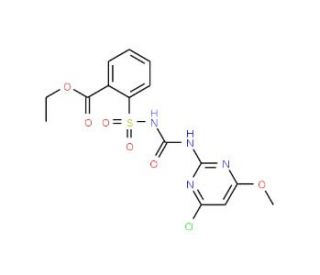

Molecular structure of Chlorimuron ethyl, CAS Number: 90982-32-4
Chlorimuron ethyl (CAS 90982-32-4)
See product citations (1)
Alternate Names:
Ethyl 2-(4-chloro-6-methoxy-2-pyrimidinylcarbamoylsulfamoyl)benzoate
CAS Number:
90982-32-4
Molecular Weight:
414.82
Molecular Formula:
C15H15ClN4O6S
For Research Use Only. Not Intended for Diagnostic or Therapeutic Use.
* Refer to Certificate of Analysis for lot specific data.
QUICK LINKS
Ordering Information
Product Citations
Description
Technical Information
Safety Information
SDS & Certificate of Analysis
Chlorimuron ethyl is a selective herbicide belonging to the sulfonylurea herbicide group. It is used primarily in agriculture to control broadleaf weeds in various crops, including soybeans, peanuts, and cereals. Chlorimuron ethyl works by inhibiting the enzyme acetolactate synthase (ALS), which is essential for the synthesis of branched-chain amino acids in plants.
Chlorimuron ethyl (CAS 90982-32-4) References
- Effect of chlorimuron-ethyl on Bradyrhizobium japonicum and its symbiosis with soybean. | Zawoznik, MS. and Tomaro, ML. 2005. Pest Manag Sci. 61: 1003-8. PMID: 15920784
- Effects of herbicide chlorimuron-ethyl on physiological mechanisms in wheat (Triticum aestivum). | Wang, M. and Zhou, Q. 2006. Ecotoxicol Environ Saf. 64: 190-7. PMID: 15925408
- Biodegradation of the sulfonylurea herbicide chlorimuron-ethyl by the strain Pseudomonas sp. LW3. | Ma, JP., et al. 2009. FEMS Microbiol Lett. 296: 203-9. PMID: 19459953
- Bioremediation of chlorimuron-ethyl-contaminated soil by Hansschlegelia sp. strain CHL1 and the changes of indigenous microbial population and N-cycling function genes during the bioremediation process. | Yang, L., et al. 2014. J Hazard Mater. 274: 314-21. PMID: 24794985
- Biodegradation of chlorimuron-ethyl and the associated degradation pathway by Rhodococcus sp. D310-1. | Li, C., et al. 2016. Environ Sci Pollut Res Int. 23: 8794-805. PMID: 26810662
- Efficient degradation of chlorimuron-ethyl by a bacterial consortium and shifts in the aboriginal microorganism community during the bioremediation of contaminated-soil. | Li, C., et al. 2017. Ecotoxicol Environ Saf. 139: 423-430. PMID: 28208114
- Biodegradation and detoxification of chlorimuron-ethyl by Enterobacter ludwigii sp. CE-1. | Pan, X., et al. 2018. Ecotoxicol Environ Saf. 150: 34-39. PMID: 29268112
- Global transcriptomic analysis of Rhodococcus erythropolis D310-1 in responding to chlorimuron-ethyl. | Cheng, Y., et al. 2018. Ecotoxicol Environ Saf. 157: 111-120. PMID: 29614448
- Transcriptomic analysis of Chlorimuron-ethyl degrading bacterial strain Klebsiella jilinsis 2N3. | Zhang, C., et al. 2019. Ecotoxicol Environ Saf. 183: 109581. PMID: 31446172
- Glutathione-S-transferase (GST) catalyzes the degradation of Chlorimuron-ethyl by Klebsiella jilinsis 2N3. | Zhang, S., et al. 2020. Sci Total Environ. 729: 139075. PMID: 32388135
- Whole-Genome Sequencing of a Chlorimuron-Ethyl-Degrading Strain: Chenggangzhangella methanolivorans CHL1 and Its Degrading Enzymes. | Yu, Z., et al. 2022. Microbiol Spectr. 10: e0182222. PMID: 35861510
- A Novel Pathway of Chlorimuron-Ethyl Biodegradation by Chenggangzhangella methanolivorans Strain CHL1 and Its Molecular Mechanisms. | Yu, Z., et al. 2022. Int J Mol Sci. 23: PMID: 36077288
- Characterization of a new chlorimuron-ethyl-degrading strain Cedecea sp. LAM2020 and biodegradation pathway revealed by multiomics analysis. | Ma, Q., et al. 2023. J Hazard Mater. 443: 130197. PMID: 36272371
Inhibitor of:
GCAT.Ordering Information
| Product Name | Catalog # | UNIT | Price | Qty | FAVORITES | |
Chlorimuron ethyl, 1 g | sc-257228 | 1 g | $105.00 |
